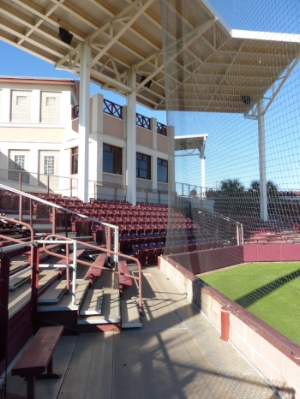Lefty Pitcher warming up at Elon’s Baseball Camp
Baseball is, notoriously, a game of failure. The MLB, NCAA, and even the Little League organization collect terabytes of statistics which back up that claim. Because every action on a baseball field is measured and quantified, we know the following: the best batters fail 70% of the time; only 23 pitchers have tossed perfect games in Major League history; less than 10% of high school players continue to play ball in college; less than 1% of high school baseball players will ever play at the professional level.
Colorado Mesa University: Suplizio Field
Would you like to know more mind-numbing, spirit-crushing stats meant to dissuade your son from ever considering playing baseball in the Major Leagues? Here is the perspective of the President of Little League (taken from a 2006 speech):
"For the five million children playing baseball in the United States, 400,000 will play ball in high school. Of those 400,000, around 1,500 will be drafted by a professional baseball team. From those 1,500 or so, 500 will play two seasons or less in the minor leagues. Of the 500 in the minors, 100 will reach the Major League level, with one making it to Cooperstown, N.Y. and the National Baseball Hall of Fame."
As I am not in the business of getting students onto the Padres, Royals or Yankees, let’s focus on the over 400,000 athletes that play baseball on the 15,000 high school teams in the US and specifically, let's focus on roughly 135,000 seniors. How many seniors will matriculate to the 1608 college level baseball programs in the US: 50,000-ish is the total number of players in all NCAA Divisions, NAIA, & NJCAA programs but, how many roster spots are available to graduating seniors: 13,000 or so.
Appalachian State: Beaver Field
Of the 50,000 athletes playing at the college level, only 10,500 play at the Division 1 level. Whittle this down further to reveal the roster spots available to incoming Freshman. Just dividing by 4 (number of years in college), my guesstimate— 2,600 players. (Note: go to the Perfect Game website to see the roughly 4,000 college commitments at all levels of college ball for the 2015 class -- from Cal Tech to Cal State Fullerton.)
University of Virginia: Davenport Field
What other dismaying numbers should parents of college-bound baseball athletes know about?
There are 302 D-1 baseball teams with 35 players allowed on the roster per NCAA rules. But, only 27 of those 35 players are eligible for scholarships. NCAA rules allow 11.7 scholarships per team.
As anyone involved in collegiate baseball will confirm, just because the NCAA allows colleges to offer 11.7 scholarships per team doesn’t mean the college administrators actually give that much money to their baseball coaches. Smaller schools often have only a few (as in 2 or 3) scholarships available per team. NCAA rules say that if any scholarship money is offered, then a minimum 25% scholarship must be offered.
College of Charleston: Patriots Point Field
How does this work in the real world? A family lucky enough to be offered just 25% of total cost of attendance at Cal State Fullerton, for example, will have to pay (or borrow) the additional 75% or $18,000 per year. A family considering the same 25% offer at Texas Christian would need to come up with $36,000 per year. Full rides? As rare as a no-hitter!
You don’t have to be a statistics major to see that because 8 players on the typical roster will not (cannot!) have any athletic aid, there are roughly 2,400 D-1 athletes playing college ball for the love of the game. If these players don't qualify for merit aid, they (or, more likely, the parents) are paying (borrowing!!) the full cost of attendance.
Obviously, the total cost of attendance at college is what drives parents to seek any and all advantage available. If Johnny can not only read well but play ball well, then Mom and Dad can potentially save big bucks. Thousands of dollars are spent annually by families trying to convert a decent earned run average into a full ride.
What's "On Deck" in this 3-part series on baseball's scholar-athletes? A riff about the recruitment racket: Are travel ball teams the minor, minor, minor Leagues?
Stay tuned...







